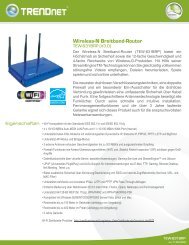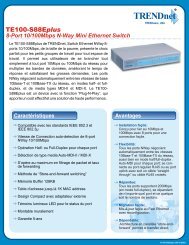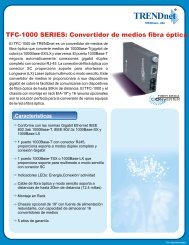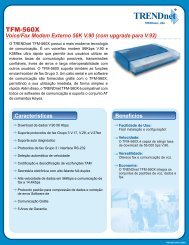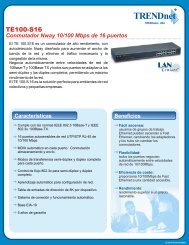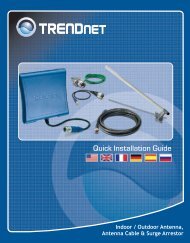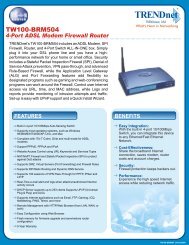You also want an ePaper? Increase the reach of your titles
YUMPU automatically turns print PDFs into web optimized ePapers that Google loves.
<strong>Wi</strong>-<strong>Fi</strong> Standards<br />
802.11b 802.11a 802.11g 802.11n draft<br />
Year Standardized 1999 1999 2003 Draft approved in 2006<br />
<strong>Fi</strong>nal standard to be ratified 2007<br />
Frequency 2.4 GHz 5 GHz 2.4GHz 2.4 GHz<br />
<strong>Wi</strong>reless Speeds 11Mbps 54Mbps 54Mbps 300Mbps<br />
Real World Speeds 4~6 Mbps 15~22Mbps 15~22Mbps At Least 100Mbps<br />
Indoor Range 30~50 Meters 30~50 Meters 30~50 Meters 150 Meters+<br />
Interoperable Standards 802.11g N/A 802.11b 802.11 n draft, 802.11b/g<br />
Advantages<br />
Ideal Solution For<br />
Interoperable <strong>Wi</strong>th 802.11g<br />
Inexpensive<br />
Home Users Connecting To The<br />
Internet <strong>Wi</strong>relessly<br />
Reduced <strong>Wi</strong>-<strong>Fi</strong> Interference<br />
More Non-Overlapping Channels<br />
Home/Office Users Experiencing<br />
Interference <strong>Wi</strong>th Existing<br />
802.11b/g <strong>Wi</strong>reless Networks<br />
Interoperable <strong>Wi</strong>th 802.11b<br />
High Speed <strong>Wi</strong>reless Data<br />
Communication<br />
Home/Office Users Needing<br />
Faster Local Network Access For<br />
Multimedia Applications<br />
Interoperable with 802.11b/g<br />
Major Increase in<br />
Speed and Coverage from<br />
802.11g<br />
Home/Office users who want<br />
better area coverage and<br />
simultaneous access to<br />
bandwidth intensive files<br />
HotSpots Available Yes No Yes N/A<br />
Range and Speed Enhancements<br />
In addition to the IEEE 802.11 standards you often find range and speed enhancement technologies referred to as MIMO, XR<br />
and Super G. MIMO is a term classifying all products that utilize the special Multiple Input Multiple Output Antenna<br />
implementations. The technology uses multiple antennas to increase the range and speed performance of your wireless<br />
signal. <strong>Wi</strong>th MIMO technology the user can get up to 800% more coverage than regular 802.11g. XR stands for eXtended<br />
Range and increases the range of your wireless signal by increasing the sensitivity of the wireless client and router. And<br />
finally, Super G is a product family that supports 108Mbps speed enhancement features. Super G MIMO, Super AG and<br />
regular Super G all have the ability of using Turbo Mode to connect at 108Mbps speeds. Stand alone wireless antennas,<br />
available in a variety of models compatible with 802.11 standards, can also be used to achieve even farther distances and/or<br />
increase the efficiency of throughput boosting technologies like MIMO and XR within a concentrated area.<br />
Security Features<br />
Protecting your data over a wireless network is important to businesses and home users alike. It is important to ALWAYS setup<br />
your wireless connection with some level of protection. The most common security is WEP (<strong>Wi</strong>red Equivalent Protocol) and<br />
allows a user to set a password of different lengths to secure your network. It adds some security, but a savvy hacker can<br />
easily break the encryption. As a result, WPA (<strong>Wi</strong>-<strong>Fi</strong> Protected Access) was created and offers a higher level of security than<br />
WEP by combining authentication and encryption. Regardless of the security you choose, remember all of the computers<br />
must use the same password or pre-shared key to be on the network. For more information on the security visit the glossary<br />
at the end of the tutorial.<br />
v2.0906<br />
<strong>TRENDnet</strong> <strong>Wi</strong>-<strong>Fi</strong> <strong>Tutorial</strong> 4



